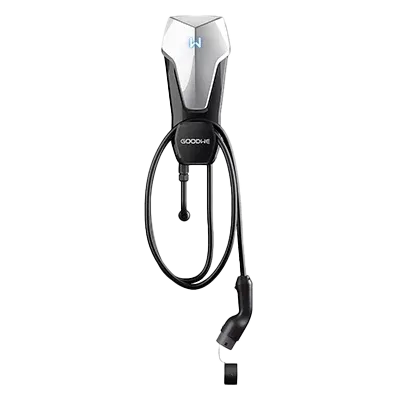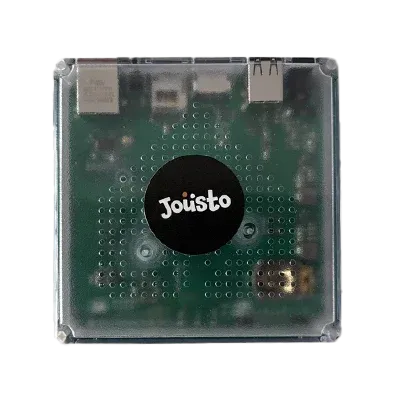
GoodWe EV Charger 7kW
Single-phase AC charger (IP66), perfect for most Aussie homes. Pair with Energy Hub for solar-aware charging.
Choose a charger, add the Jousto Energy Hub to charge from sunshine and cheap off-peak power, then book installation. Simple, smart, and ready for every EV.

Quality hardware, great value — and smarter with the Jousto Energy Hub.

Single-phase AC charger (IP66), perfect for most Aussie homes. Pair with Energy Hub for solar-aware charging.

Faster AC charging for three-phase homes and EVs that support higher rates. Solar-smart with Energy Hub.

Make charging solar-aware on day one. Includes Genius Agent to guide your self-setup & automations.
Learn more about the Jousto Home Assistant Genius.
Choose your charger
Pick 7kW or 22kW GoodWe model.
Add the Energy Hub
$249 with Genius Agent for self-setup.
Checkout online
We’ll confirm details and schedule install.
Charge on sunshine
Smart modes for solar and off-peak.

As energy prices climb and climate variability intensifies, Australian homeowners are becoming increasingly focused on achieving both comfort and cost-efficiency in their living environments. In a country as climatically diverse as Australia, where residents contend with both chilly winters and scorching summers, managing seasonal comfort effectively can be both a financial and practical challenge.
To assist households in navigating these issues, the Australian government has introduced the Residential Efficiency Scorecard—a tool designed to assess and improve the energy performance of existing homes. Unlike generalised advice or high-tech automation platforms such as Jousto, the Scorecard offers tailored, in-person assessments and data-driven insights into how a home performs thermally and where improvements can be made.
This blog explores the unique strengths of the Residential Efficiency Scorecard in addressing both winter warmth and summer savings, highlighting how it compares to online advice and automated energy tools. The goal is to help homeowners better understand which energy efficiency strategies deliver the greatest comfort and return on investment throughout the year.
The Residential Efficiency Scorecard is a government-supported initiative available across several Australian states and territories. Its primary aim is to provide homeowners with a clear, evidence-based understanding of how their home uses energy and how efficiently it retains comfort.
A certified Scorecard assessor visits the property and collects data on a wide range of factors, including:
Construction materials
Roof, wall, and floor insulation
Windows and shading features
Fixed appliances such as heaters, air conditioners, and hot water systems
Onsite solar PV systems
Lighting efficiency
This assessment results in:
An Energy Star Rating (out of 10), which estimates the running costs of fixed appliances
Hot and Cold Weather Comfort Ratings (out of 5 bars), indicating how well the home naturally maintains comfortable indoor temperatures
A detailed report with tailored recommendations
A Scorecard Certificate, useful for green loans and resale purposes
What sets the Scorecard apart is its focus on existing homes and the way it combines both building envelope data and appliance efficiency to form a complete energy picture.
Cold-weather comfort is a major concern for Australian households, particularly in southern states where winter nights are long and temperatures can fall below freezing.
The Scorecard assigns a Cold Weather Comfort Rating based on:
Insulation quality and coverage
Window type (e.g. single or double glazing) and treatments (e.g. pelmets, curtains)
Draught sealing and air leakage
Heating type and efficiency
Room sizes and layout
Thermal mass and material responsiveness
This detailed analysis determines how well the home holds heat without relying on mechanical heating, making it more cost-efficient and environmentally sustainable.
Online winter tips—such as setting thermostats to 20°C or using door snakes—are useful but not home-specific. They don’t tell you whether your ceiling insulation is working effectively or whether your heating system is oversized, inefficient, or outdated.
By contrast, the Scorecard offers a diagnostic approach. For example, it might recommend:
Adding R4 ceiling insulation
Upgrading from gas ducted heating to a reverse-cycle heat pump
Installing pelmets to reduce window heat loss
These improvements are backed by estimated cost savings, providing a clear path to smarter, warmer living during winter.
While winters are a comfort concern, Australian summers pose the opposite problem: excessive heat and high cooling costs. Here too, the Scorecard provides targeted advice that can reduce a home’s reliance on air conditioning.
The Scorecard calculates a Hot Weather Comfort Rating, considering:
Roof and wall insulation effectiveness
Window orientation and shading
Glazing type and solar heat gain
Cooling system efficiency
Opportunities for natural ventilation
Roof colour and thermal reflectivity
A home with good summer performance may stay naturally cooler during heatwaves, reducing the need for energy-intensive cooling systems.
Most online advice recommends:
Using ceiling fans
Setting the aircon to 26°C
Closing blinds during the day
Ventilating at night
These tips are sound but don’t diagnose why your home overheats in the first place. The Scorecard’s in-depth analysis might reveal, for instance, that:
You’re lacking shading on west-facing windows
Your air conditioner is inefficient or too small
You’re missing cross-ventilation pathways
With this insight, homeowners can invest in upgrades that provide lasting summer savings.
What makes the Residential Efficiency Scorecard more than just another energy advice tool?
While many resources focus on either appliances or building shell, the Scorecard covers both, offering an integrated view that mirrors real-world energy use.
Unlike websites and brochures, the Scorecard delivers bespoke advice, such as:
"Install a heat pump hot water system to reduce water heating costs by $300/year"
"Replace single-glazed windows on the northern side to improve winter retention"
These are actionable, home-specific upgrades with estimated benefits—not just tips.
Scorecard results are measurable, allowing you to track progress. The star rating and comfort bars make it easy to:
Compare homes
Apply for green loans or rebates
Set improvement targets over time
The Scorecard doesn’t just highlight problems—it helps prioritise solutions based on cost-effectiveness.
Typical Scorecard reports include cost estimates for each recommended upgrade and a return-on-investment timeline. For example:

This information is invaluable for homeowners deciding which upgrades to tackle first, especially when working with a renovation budget.
The Scorecard offers a set of clear, visual metrics:
Reflects total energy cost from fixed appliances. A higher score = lower bills.
Measured in bars out of five. They assess passive comfort—how well the home stays warm or cool without artificial heating or cooling.
These show which appliances (e.g. hot water systems, heaters) are underperforming and where savings could be made.
Together, these metrics offer a full spectrum picture of both current performance and future potential.
Although Jousto and the Scorecard serve different purposes, they can be strategically combined for better results.
Scorecard = Evaluates the home's physical performance
Jousto = Optimises energy usage using smart automation
Scorecard tells you what to fix (e.g. upgrade insulation), while Jousto tells you how to run your home smarter (e.g. when to heat or cool based on solar availability or wholesale prices).
Step 1: Scorecard Assessment
→ Understand and improve your home's baseline energy efficiency
Step 2: Implement Upgrades
→ Seal draughts, improve insulation, replace inefficient systems
Step 3: Use Jousto for Smart Control
→ Automate heating, cooling, and appliance use for maximum savings
Together, they form a powerful energy performance + energy behaviour partnership.
Let’s consider a typical Adelaide family:
4-bedroom 1980s brick veneer home
Gas ducted heating, no insulation
Single-glazed windows
Reverse-cycle split system in the living room
6.6kW rooftop solar
High winter bills ($500/month)
Overheating in summer
Running aircon inefficiently during peak hours
Added R4 insulation
Replaced gas heating with electric heat pump
Installed external shading on north-west windows
Joined Jousto to automate cooling during low-price periods
Result: Energy bills dropped by 35%, and the home became significantly more comfortable year-round.
Before a major renovation – integrate smart energy upgrades
When selling a home – improve star rating for added appeal
When switching to all-electric living – assess readiness
For first-home buyers – understand long-term energy costs
When seeking a green loan – use the Scorecard certificate as proof
The Residential Efficiency Scorecard provides unmatched insight into how Australian homes perform across both winter and summer. Where general tips stop, the Scorecard begins—with personalised assessments, practical upgrade suggestions, and clear metrics that guide long-term comfort and savings.
Unlike high-tech solutions like Jousto, which optimise energy usage through automation, the Scorecard focuses on the physical and structural energy profile of the home. But when used together, these tools can help homeowners achieve holistic, year-round efficiency—from construction to consumption.
For any homeowner seeking to create a comfortable, energy-efficient, and climate-ready home, the Scorecard is not just an option—it’s a foundation.
Ready to take full control of your home's comfort and energy costs? Start with the Residential Efficiency Scorecard to uncover where your home could perform better—whether it’s insulation, heating, or cooling. Then, once your home is energy-fit, Jousto’s smart automation steps in to fine-tune your energy usage in real-time, using solar, battery, and price signals to save even more.
✅ Get your home assessed with a personalised Scorecard evaluation
✅ Implement targeted upgrades to improve comfort and reduce bills
✅ Let Jousto optimise usage with automation based on solar and price data
Together, the Scorecard and Jousto deliver a powerful one-two punch for year-round comfort and long-term energy savings.
👉 Learn more about the Residential Efficiency Scorecard
👉 Discover how Jousto can automate your energy smarter
Smart homes aren’t built overnight—but with the right insights and the right automation, yours can be.

© Copyright 2025.Honen Lead Generation.
All Rights Reserved.
Phone: 0489 261 333
185 Morphett St, Adelaide, SA, 5000